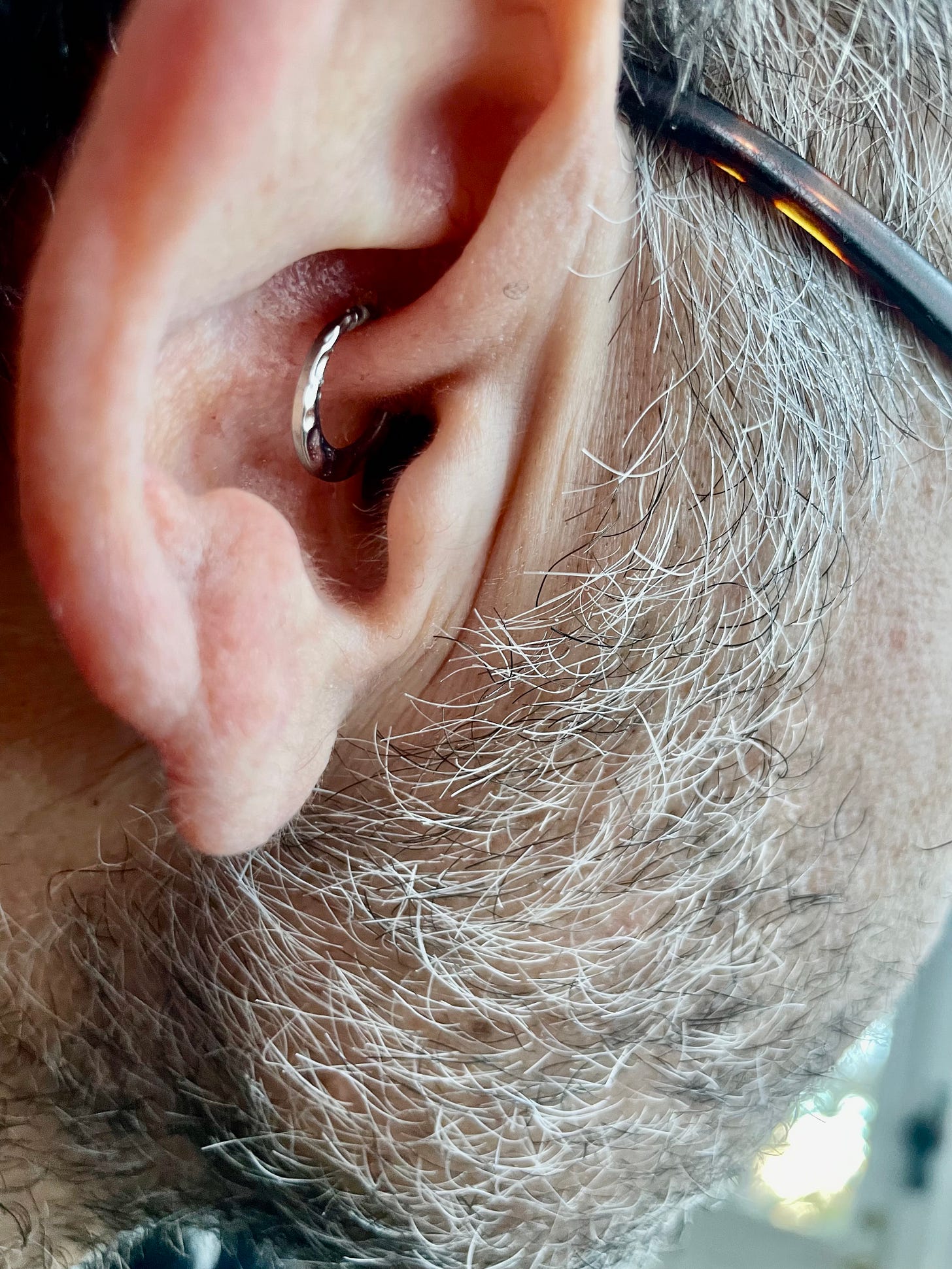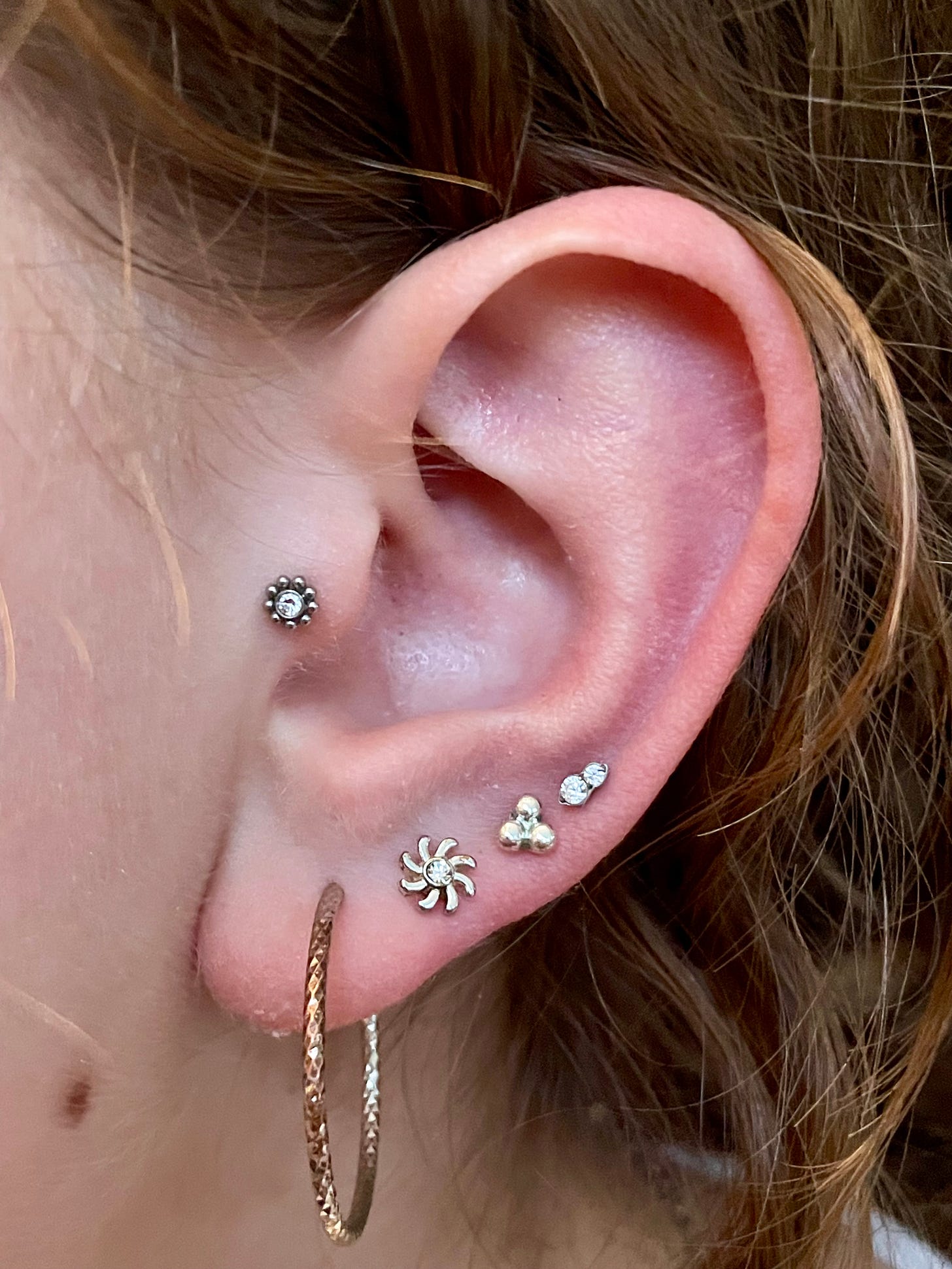When we were 30 and just having our first child, my husband woke up one day nauseous, light sensitive, feeling like his head was about to explode.
“Did you ever see that movie in the ‘70s, Scanners?” he asked. “That’s how my head feels, like it’s going to burst from the inside. I wonder if the drill through the forehead would help? It didn’t seem to for the guy in the movie.”
A first migraine
We realized that he was having his first migraine. His grandmother had suffered from them all her life, but he didn’t think it had been passed on to him genetically, and knew that more women got them than men.
I told him to lie down in the bedroom and I closed the shades and doors, making it as dark as possible. I put a bucket by his side (in case he needed to vomit), and let him lie still in the quiet room all day long, unable to do anything to distract himself from the pain and nausea or relieve the boredom.
By the next day, it was mostly gone—his head felt like a rung bell that was still ringing, and some nausea lingered in the pit of his gut, but he was functional.
That first day was the worst—or seemed so—but he began getting them several times a year.
Over the decades, they became less debilitating but more frequent, until he was having them 3-4 times a month, for 1-4 days.
He had to live on ibuprofen, which he didn’t like taking, but nothing else worked for him.
He looked for triggers, talked to doctors, tried alternative preventions and remedies, had acupuncture and chiropractic, but nothing helped much.
James developed his own protocol with hot showers, meditation, espresso, acupressure, and supplements (magnesium, Co-Q10, and turmeric), which all seemed to help.
A little.
Sometimes.
In the meantime, he never stopped looking for a cure.
The trivia team comes up with the answer
One evening last year he was out at a weekly trivia game with his regular team. His friend, a retired M.D., was talking to another friend who also suffered from migraines.
“You could try the piercing,” she suggested.
My husband’s ears perked up.
“Are you talking about migraines? What ‘piercing’?!” he asked.
They explained that there was an unusual ear piercing, right along the where the vagus nerve branches through the ear, that many people had found helped their migraines.
He was not a man for piercings—he doesn’t even wear any jewelry, other than a wedding ring—but was ready to try anything.
He couldn’t find any statistically significant studies in the scientific literature, but an online community of migraine sufferers polled their members who had the piercing.
Of 1,100 respondents, more than two thirds had noticed significant reduction in frequency of migraines, intensity of migraines, or both. One fifth of the respondents hadn’t had a migraine since.
James decided to try it. He went in person to local piercing shops. The first piercer blabbered on about how they couldn’t offer piercings to treat anything medical, and about how there was ‘no evidence’; but he could just try it anyway. If it didn’t work, the piercer said, he’d still have a cool piercing, and if he didn’t like that, he could take it out.
The second piercer was more enthusiastic and encouraging.
“I get women coming in all the time for this. They come in with a migraine. Ninety-five percent of the time they walk out without one. I can put it in the right spot, very close to the nerve.”
“Daith thou want to be free of migraines?”
This piercing is called a “daith.”
It’s an edgier piercing, deep in the middle of the whorls of the ear, through thick cartilage.
It was invented around 1990, named for a Hebrew word for knowledge, and meant to be pronounced ‘doth,’ as in “Doth thou wish to be free of migraines?”
The needle goes in behind a fold of the ear in a spot that can’t be seen from the front, and comes out just inside the ear canal itself.
While in the U.S. piercers can’t offer it for medical purposes, in the U.K. there’s a whole chain business that does nothing but this piercing for migraine sufferers.
The theory is that this piercing affects the VNS, or Vagal Nervous System. The vagal nerve is the biggest, most complicated nerve in the body. It controls a lot of functions, including inflammation. By pressing on the vagal nerve, the piercing reduces inflammation of blood vessels in the brain.
A piercing experience
James went back to the second piercer with our teenage daughter, who loves piercings, as a bonding experience.
The piercer looked carefully, then quickly and confidently put the long, curved, hollow needle through. It made crunchy noises as it went through the cartilage, which my husband found more noticeable than the pain.
James walked out with a shiny silver hoop in the middle of his ear.
That was six months ago, and he hasn’t had a migraine since.
He feels freed of them.
He thinks that maybe once or twice the morning sunlight has looked a little bright (that was his migraine ‘tell’), but he couldn’t perceive any pain or nausea.
Maybe the top of his right eye felt a little pressure?
Maybe not.
He wonders if they’re gone, or just so infrequent and so mild that they aren’t even noticeable.
But who cares? The daith worked for him, and that’s good enough.
Related articles:
How To Make Your Headache Go Away
Scientific Reasons To Grow Indoor Plants
A Hack For Your Rack





Awesome story. I’ll keep this in mind. Praying for your return to full health, Jennifer.
Has no one with migraines been informed of how extremely well significant portions of Turmeric Root Powder reduces swelling with the only drawback being one's own limit to how much TRP to take.
I have never experienced migraines. I have had headaches, but they stopped some years ago when I started experimenting with a 1/3rd gram of TRP from Now brand supplements. After a year or so, I came across a nutritionist who said she had no difficulties with a whole gram daily. She also tole me I would know when I had reached my limit when I began sensing abdominal nausea or saw a faint orange tint in the skin, usually the arms. That inspired me to begin slowly upping my daily intake. I felt no nausea or saw no coloring until I reached two grams daily. I also found I was both losing weight and feeling like my whole head was clearing, and I had no more asthma, no more headaches, and no nausea when I backed off to 1.5 grams daily.
Now I am at 1 gram daily, and feel better at age 78.75 years than I did at sixty. I can only say it has never caused me any other issues.
I have read several times that India has used it for thousands of years, and the Ayurveda practitioners know precisely how to use it.
I know none of them, but found experimenting on myself was a wonderfully liberating experience. I went back to regular yoga practice, which I now do 5-6 days weekly, and will not surrender until something hurts and proves irreversible.
I find myself experimenting in every facet of my life, from negotiating with family members to gardening to playing basketball with my eight year old grand son to walking 6-8 miles on the beach to hiking the redwoods in central coastal CA, to testing how refined I can increase the fuel mileage on my auto (holding speed at/below 65 mph & rpm at/below 2500 peaks out mpg) and so on.
I wish many more US medical students would study Ayurveda; the American woman who discovered the serious use of turmeric root powder in India was a Harvard student on a self-selected study of medicine in India. I read her in the late '90s and decided it was time for me to stop being so timid with the Now brand capsules. I initially doubled them then tripled them.
Sorry, I lost her article and forgot her name.
That was helping my whole disposition with each change. By the early 2010s I was experimenting more with using the bulk bags of TR Powder in various ways, from cooking to salad dressings to fruit salads to whatever I preoared in the kitchen. Then I decided to become more systematic about it, and that was when thing became most interesting and helpful.